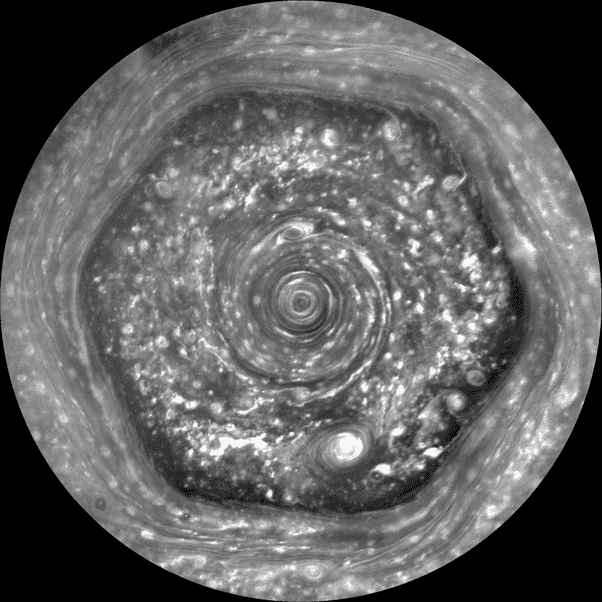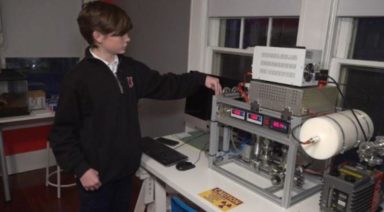Glitch Discovered In Saturn’s Rings By Cassini Spacecraft Images

NASA’s Cassini spacecraft recently ended its 20-year mission to Saturn. It was the first spacecraft to ever orbit the massive gas giant to study the planet’s myriad features, such as its extensive system of rings. These seemingly perfect bands of ice and rock had been photographed before and were thought to be mostly understood by astronomers, until Cassini found a rare exception: A glitch on the outer edge of the planet’s A-ring.
Is Peggy Just a Moonlet?
Launched in 1997, the Cassini spacecraft has always been on a suicide mission, albeit one filled with scientific discovery. That mission lasted just under 20 years, and its final days resulted in some of the most exciting images of the second largest planet in our solar system. The spacecraft discovered two new moons, deployed a probe that landed on Titan, and slipped between two layers of rings in its orbit.
Over its 10-year orbital period, images from Cassini began to show something that has still gone unexplained, a glitch in one of the rings. This glitch was first discovered by a long-time member of the imaging team, Carl Murray, who named it after his mother-in-law, Peggy, whose birthday it was.
When first imaged in 2013, Peggy was about 1.5 miles wide, and imperfect compared to Saturn’s otherwise pristine circuits. Because of its tiny size, the Cassini spacecraft was unable to capture it in great detail or within close proximity, but it was enough to recognize its anomalous nature. Murray and his NASA colleagues said they believed Peggy to be either a moon in the making or a moonlet disintegrating, as she got smaller during future imaging.

nasa.gov
Saturn’s rings consist of countless particles of ice and rock that orbit within the Roche Limit, an area where the planet’s gravitational force becomes so strong it rips apart small celestial bodies, such as asteroids and meteors. Typically, these particles will coalesce to form moons, but Saturn’s pull prevents this, instead maintaining their orbit. These small lunar building blocks are sometimes referred to as moonlets.
At first, scientists believed Peggy might have been a full-fledged moon, disrupting the flow of Saturn’s orbiting moonlets, but this theory was discounted because they would have expected it to create more chaos.
According to NASA, it has been difficult to track Peggy, as she’s not always been where they expect her to be. And though scientists believe Peggy may have been a nascent moon at one point, she still remains within the not-fully-explained category of Saturn’s features.
Strange Features In Images From Cassini Spacecraft
The Cassini spacecraft gave us quite a bit of new information about Saturn’s many moons, including the fact that some of them could potentially support life. The Huygens probe, carried by the Cassini spacecraft, landed on Titan, a moon with a significant amount of surface water.
Another of Saturn’s moons, Enceladus, is thought to contain vast oceans beneath a layer of ice on its surface. These discoveries have raised the question of whether there is a possibility of life on these moons, as well as some other interesting theories.

The most unusual moon in Saturn’s orbit is one known as Iapetus. This walnut-shaped satellite has some odd features which some believe are characteristic of an artificial satellite. One half of the moon is bright white, while the other side is dark black with almost no reflectivity. There is a ridge running along its equator that alternative theorists have likened to two independent half-shells welded together. Others have imagined it to possibly be a wall of sorts.
Some have pointed out that it’s odd shape resembles a dodecahedron, evidence of artificial construction compared to the more spherical shape of natural satellites. Further study of Iapetus’ lunar surface shows additional geometric features with lines just a little too straight to be the product of natural mechanisms.
David Icke has proposed the idea that Saturn’s rings are actually artificial, based largely on a book titled Ringmakers of Saturn. He says he believes that Saturn is a broadcasting system, amplifying a frequency that is directly tied to our perception of reality. He points to the similarity between the rings of Saturn and information encoded on a CD or DVD.
Icke says he believes this signal is malevolent and that it’s broadcasting a false reality. He says these satellites orbiting Saturn are electromagnetic vehicles creating the rings, and that one can see exhaust being emitted in the process. Icke says he believes Saturn used to be a star like the sun, but that it is now being used to resonate sound frequencies.
There are, in fact, strange radio signals being broadcast from Saturn which can be found on NASA’s website. Could these eerie tones, that sound like something straight out of a horror movie, actually have an effect on Earth and our consciousness?
Another bizarre discovery on Saturn that has puzzled scientists and alternative theorists alike, is the massive hexagonal storm on the planet’s north pole. This storm stretches over 20,000 miles wide and reaches down at least 60 miles into the planet’s atmosphere. Its distinctively straight sides show how the winds in this gaseous storm shift direction drastically, a phenomenon never observed before.

David Wilcock draws the connection between the storm’s shape and Hans Jenny’s discovery of colloidal suspension. Jenny showed the way that sound frequencies create geometric patterns in solutions where particles are suspended in water and gas.
Could there be a connection between Icke’s theory of Saturn as a frequency transmitter and this massive hexagonal storm on the its north pole?
Secret Space Programs and Breakaway Civilizations

In July 2014, on the 45th anniversary of Apollo 11’s moon landing, the government declassified information about a secret space program from the 1950s called Project Horizon. The plan outlined the building of a permanent military base on the moon. Ten to twenty men would be sent with all their supplies and nuclear weapons. The secret moon base would be used for surveillance against and protection from the Soviet Union, and the men would have constant communication with the Earth.
The released documents show that the scientists knew it wasn’t possible to implement the plan, but it was expected to be put in place as technology advanced. Project Horizon never got off the ground. But, that isn’t the end nor the beginning of the story about secret space programs from the past, present and the future.
Secret Space Programs and FDR
In the 1940s, according to recently released documents, President Franklin Delano Roosevelt commissioned a secret space program. He was concerned about how to move large numbers of people in case of nuclear war to avoid massive radiation damage. He thought there might also be a need to escape the ravages of some other global cataclysmic event. Since there was no place on Earth to which large masses of people could be moved, he considered the possibility of moving to locations in space.
At first, moving to the nearest star, Alpha Centauri, seemed like an option. However, the distance made such a plan impossible. As a next step, FDR focused on the moon, Mars or Venus as alternatives to Earth.
Beginning in 1945 at the conclusion of WWII, after President Truman took over, he brought 1,500 German scientists and engineers to the U.S. The scientists, under Hitler’s leadership in Nazi Germany, made advancements in the development of flying saucers, like the Nazi Bell, before and during the war. The German scientists worked at Fort Bliss, near El Paso, Texas, and were assigned the task of developing secret space programs under the project name of Operation Paperclip.
Truman believed the Germans had knowledge of anti-gravity propulsion engines and other spacecraft flight technology. Werner von Braun was the most well-known member of this group, who eventually became the designer of the Saturn V launch vehicle, which was used to propel American astronauts to the moon. He eventually became the director of NASA’s Marshall Space Flight Center and spoke out frequently about the need for space exploration.
Secret space programs are believed to be financed by secret “Black Budget” programs with contributions made by people with great wealth, private contractors and some government agencies. This secret funding keeps the programs from being subject to congressional oversight. Since the early 1960s, the programs have been kept secret even from the president: A memo was found in the newly released documents that said to keep “Lancer,” President Kennedy’s secret service nickname, out of the loop.
Secret Space Programs and Breakaway Civilizations
Secret space programs may have developed Breakaway Civilizations in outer space. Well-respected UFO and space researcher Richard Dolan, defines a Breakaway Civilization as a secret group of technologically advanced people who don’t share their knowledge with the rest of the world. These are essentially the Earth’s elite who have knowledge far above the rest of the world.
These elite may know of an upcoming imminent global geological cataclysm event and are building space bases as shelters for themselves. For example, they could be planning their escape from Nibiru Planet X, which “triggers comet showers” every 27 million years. One of those comets is expected to crash into the Earth and totally destroy it sometime in the not too distant future.
Scotland native, Gary McKinnon, hacked into thousands of government secret files. He found evidence of an anti-gravity propulsion system that traveled at incredible speeds. Also, he found evidence of portal technology that, when coupled with anti-gravity propulsion, would allow space travel to other stars and planets to be accomplished in a short amount of time.
It appears that Einstein’s theory that nothing can travel faster than the speed of light has been debunked. It also appears the Black Budget keeps these secrets even from NASA, since NASA apparently does not have access to anti-gravity technology. It still propels its rockets with fossil fuel.
McKinnon claims he saw nearly 300 photos of structures and civilizations existing on the back side of the moon. He says these structures (alien bases on the moon) are erased out of any photos when they are released to the public. Unfortunately, when he hacked into the computers, he was using a dial-up connection so he couldn’t download the photos. He says he took a screenshot of one that was saved on his computer, but his computer was seized when he was arrested. When his computer was subsequently returned to him, the photo was gone.
McKinnon also reported viewing a file that included names of “non-terrestrial officers” who he says were assigned to ships that weren’t U.S. Navy ships. He concluded these were the officers assigned to space ships, not navy ships, indicating that Breakaway Civilizations already exist.
There are many outstanding questions about secret space programs. Why do these programs remain secret? Will there be an opportunity for non-elite citizens to be part of a Breakaway Civilization? A poll taken in 2015 shows that 54 percent of Americans believe extraterrestrial intelligence exists. With such a large number of people supporting alien existence, why is there still a need to maintain secrecy?
Want more like this article?
Don’t miss Deep Space on Gaia for more on the long and hidden history of Earth’s secret space program.




































